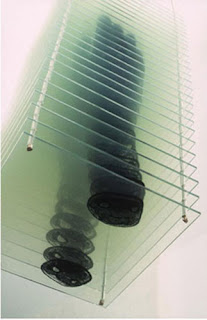Nanotech + Art
After reading The Nanomeme Syndrome: Blurring of fact & fiction in the
construction of a new science By Jim Gimzewski and Victoria Vesna, I got a
better understanding of the Nano size and how nanotechnology will drastically
change the future of humanity. The direction of this field is beneficial to aid
environmental issues, advancing the medical field, engineering, and changing
the human biology. Connecting the article to the lecture videos I kept asking
myself, how is this going to change the way we view art? considering everything
Nano related is invisible to the naked eye.
The first
artwork I consider is the pattern created by The Scanning Tunneling Microscope (STM)
that was created in 1980 by IBM. This device was new form of a microscope that
used a needle to map the surface of an atom and sent the images to a computer.
This image illustrates the depth mapping of silicon. With a computer program
the map can be colored to express the different heights and crevasses on the
surface with different colors. This creates a beautiful image that I consider
nanotech art. Below are the images this microscope created with color. The yellow area is a higher depth than the dark orange spots. This surface depth and atoms are completely invisible to the naked eye. The actual surface is from silicon.
The STM was also able to do something that was
never achieved before. This device can manipulate and move atoms to a desired
location and create a chemical bond. A graduate
student named Lisa from UCLA created some colorful school art, she was a student of Jim Gimzewski. This is
a photo of rearranged atoms to create four letters that display UCLA created by
Lisa. Aside the picture is another manipulation of molecules to create a triangle, circle, square and hexagon created by Don Eigler


Seeing the images and photographs of nanotech
art my question was answered. The art produced in the Nano size is viewed by
computer programs and photographs. The art created is simply amazing after
knowing the actual size of the atoms we are viewing. Nanotechnology is continuing
to surpass previous benchmarks in science, and with its advancement new art
will emerge with it.
REFERENCES
Curtin, John.
"Art in the Age of Nanotechnology." Art.base. N.p., n.d. Web. 27 May
2017. <https://art.base.co/event/2104-art-in-the-age-of-nanotechnology>.
Gemzewski,
Jim. "Nanotech for Artists." UConline.edu. University of
California. Web. 26 May 2017.
<https://cole2.uconline.edu/courses/63226/wiki/unit-8-view?module_item_id=970451>.
Lovgren,
Stefan. “Can Art Make Nanotechnology Easier to Understand?” National
Geographic. 23 December 2003. Web. https://news.nationalgeographic.com/news/2003/12/1223_031223_nanotechnology.html
Murthy,
Shashi K. "Nanoparticles in Modern Medicine: State of the Art and Future
Challenges." International Journal
of Nanomedicine. Dove Medical Press, June 2007. Web. 28 May 2017
Victoria
Vesna. "The Nanomeme Syndrome." The Nanomeme Syndrome: Blurring of Fact & Fiction
in the Construction of a New Science. N.p., n.d. Web. 28 May 2017.




Comments
Post a Comment